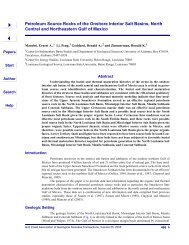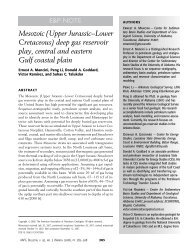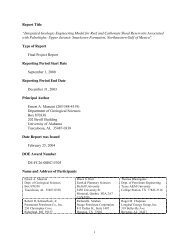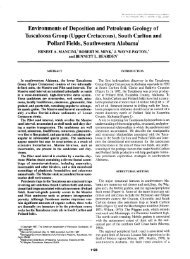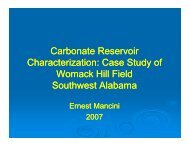Part 4 - Berg - Hughes Center
Part 4 - Berg - Hughes Center
Part 4 - Berg - Hughes Center
You also want an ePaper? Increase the reach of your titles
YUMPU automatically turns print PDFs into web optimized ePapers that Google loves.
lenses; 3) Cook Mountain, fossiliferous marine clay unit, and 4) Cockfield, composed<br />
mainly of fine-grained sands and silts (Andersen, 1960, 1993).<br />
The Eocene Jackson Group outcrops in a line trending northeast from the southern<br />
part of Sabine Parish through Grant and La Salle Parishes. Therefore, in northern<br />
Louisiana, this group is absent at the surface where only Claiborne and Wilcox Groups<br />
are present. The Jackson consists of fossiliferous clay and limestone and thick clays.<br />
The Oligocene Vicksburg and post-Oligocene strata form thin outcrop slivers that<br />
more or less parallel the older Jackson Group in Sabine, Natchitoches, Grant, La Salle<br />
and Catahoula Parishes. The Vicksburg consists of a basal crossbedded sand, a middle<br />
fossiliferous bentonic clay, and an upper marly clay unit. The Miocene strata consist of<br />
fine- to medium-grained sand overlain by a bentonitic clay and silt unit (Fleming)<br />
(Andersen, 1960, 1993). The depositional history in northern Louisiana is completed by a<br />
Pleistocene sedimentary sequence consisting of “terraces and valley trains” that can be<br />
observed mainly along the Red and Ouachita Rivers, and their tributaries, and as Recent<br />
alluvium that unconformably overlies the Tertiary deposits (Murray, 1948; Andersen,<br />
1960, 1993).<br />
This section was prepared by Donald Goddard with contributions by Ernest Mancini.<br />
Burial History<br />
Understanding burial history is important to interpreting the geohistory of a basin.<br />
Burial history is critical to petroleum system identification and assists in determining the<br />
generation, expulsion and migration of hydrocarbons in the basin.<br />
Study of the wells, regional cross sections (Figs. 3-13), and burial history profiles<br />
(Figs. 41-82) indicate that there are differences in the geohistory for various areas of the<br />
383




